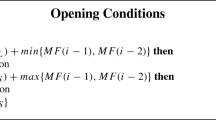Abstract
This paper develops trading strategies for liquidation of a financial security, which maximize the expected return. The problem is formulated as a stochastic programming problem that utilizes the scenario representation of possible returns. Two cases are considered, a case with no constraint on risk and a case when the risk of losses associated with trading strategy is constrained by Conditional Value-at-Risk (CVaR) measure. In the first case, two algorithms are proposed; one is based on linear programming techniques, and the other uses dynamic programming to solve the formulated stochastic program. The third proposed algorithm is obtained by adding the risk constraints to the linear program. The algorithms provide path-dependent strategies, i.e., the fraction of security sold depends upon price sample-path of the security up to the current moment. The performance of the considered approaches is tested using a set of historical sample-paths of prices.
Similar content being viewed by others
References
R.F. Almgren, Optimal execution with nonlinear impact functions and trading-enhanced risk, Applied Mathematical Finance, to appear 2003.
R.F. Almgren and N.Chriss, Optimal execution of portfolio transactions, Journal of Risk, 3, pp. 5–39, 2000.
T.W. Anderson, The Statistical Analysis of Time Series. New-York, John Willey&Sons, Inc., 1971.
T.W. Anderson, An Introduction to Multivariate Statistical Analysis. New-York, John Willey&Sons, Inc.
D. Bertsimas and A. W. Lo, Optimal Control of Execution Costs, J. Financial Markets, 1, pp. 1–50, 1998.
Birge, J.R., Louveaux, F. (1997): Introduction to Stochastic Programming. Springer Verlag.
Kukush, A.G., Silvestrov, D.S. (2000): Structure of Optimal Stopping Strategies for American Type Options. In
Mulvey, J.M. and Vladimirou (1992) Stochastic Network Programming for Financial Planning Problems, Management Science, 38, pp. 1642–1664.
C. H. Papadimitriou and K. Steiglitz (1988), Combinatorial Optimization: Algorithms and Complexity. Dover Publications, Inc.
A. Prekopa (1995), Stochastic Programming. Kluwer Academic Publishers.
S. Uryasev and P. Pardalos (2001), Stochastic Optimization: Algorithms and Applications. Kluwer Academic Publishers.
S. Uryasev and R. T. Rockafellar (2000), Optimization of Conditional Value-at-Risk, Journal of Risk, 2, 21–41.
Author information
Authors and Affiliations
Rights and permissions
About this article
Cite this article
Butenko, S., Golodnikov, A. & Uryasev, S. Optimal Security Liquidation Algorithms. Comput Optim Applic 32, 9–27 (2005). https://doi.org/10.1007/s10589-005-2052-9
Issue Date:
DOI: https://doi.org/10.1007/s10589-005-2052-9




